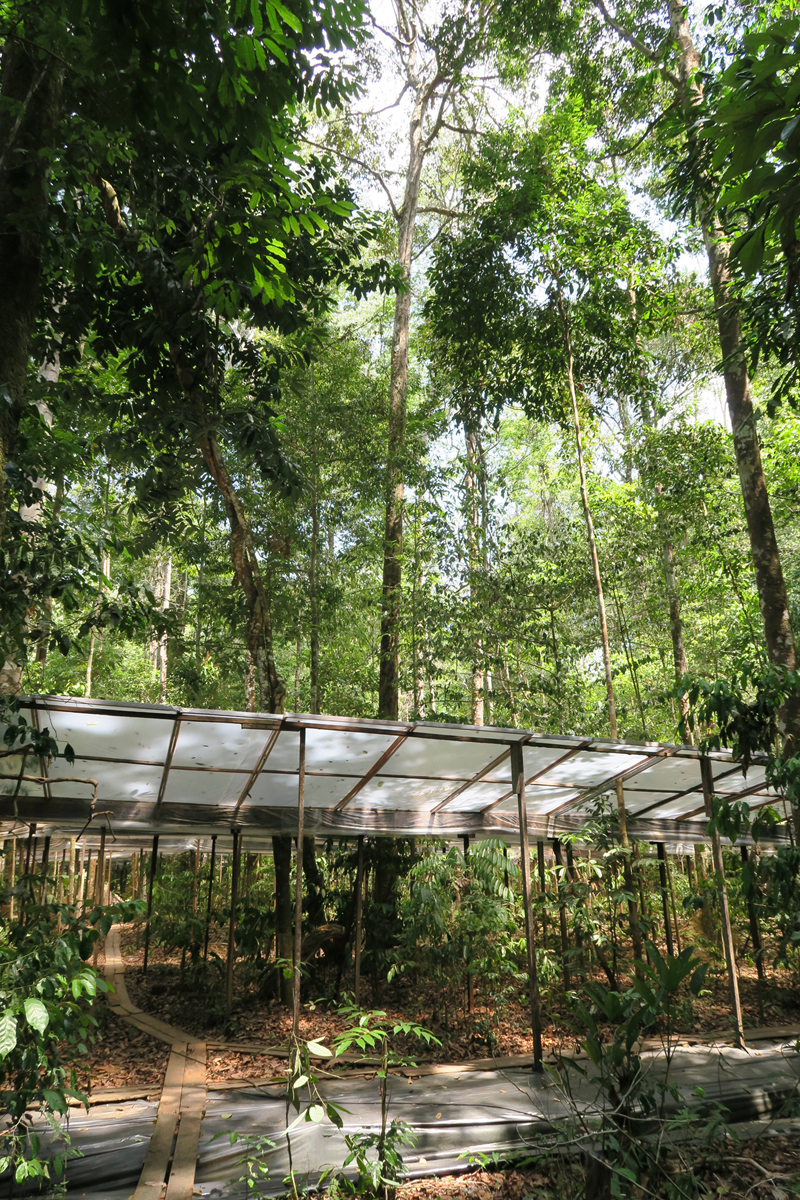- A 2012 study found 70 percent of tree species to be particularly vulnerable to drought conditions.
- A new study by University of Edinburgh researchers confirms that hydraulic failure in trees’ xylem, a tissue that facilitates the moving of water from the roots to the leaves, appears to be the key trigger of mortality from drought stress.
- The University of Edinburgh researchers have been conducting a drought experiment in the Amazon for the past 13 years.
Earlier this month, researchers said that 40 to 60 percent of the more than 15,000 tree species they studied in the Amazon meet the criteria to be listed as threatened on the International Union for Conservation of Nature’s Red List.
They arrived at that estimate after considering the impacts of historical and projected deforestation, but past studies have arrived at similarly dire conclusions after looking at how impacts of climate change such as increased droughts will affect the world’s forests.
In 2012, for instance, a study of the effects of drought on 226 tree species at 81 sites in different biomes around the world found that 70 percent of the species sampled are particularly vulnerable when faced with reduced water availability.
Now scientists have determined that it might very well be the tallest trees in the Amazon that die off first due to coming droughts.
A team of researchers with the University of Edinburgh in Scotland, who have just published the results of a 13-year study in the journal Nature, found that trees’ water transport systems break down under drought conditions, leading to their death.

The researchers are conducting one of the longest-running drought experiments of its kind ever attempted. They’ve monitored tree growth, sugar levels and performance of water transport systems to compile a decadal-scale data set on the effects of soil moisture depletion in tropical forests.
The experiment is being conducted on two one-hectare (about 2.5 acres) plots of land in Brazil’s Caxiuanã National Forest Reserve. On one plot, plastic panels and gutters were placed above the ground, in order to exclude about half of the area’s rainfall. A corresponding control plot was also included in the study.
After the ten-year mark, the researchers say, there was a pronounced increase in tree mortality in the plot subjected to drought-like conditions.
“The mortality signal was dominated by the death of large trees, which were at a much greater risk of hydraulic deterioration than smaller trees,” they write in the Nature article.
They say their results suggest that decades-long soil moisture depletion in tropical rainforests leads to accelerated biomass loss and will likely cause a transition to forests dominated by shorter trees that store less carbon.
The results appear to confirm the conclusion of the 2012 study that found 70 percent of the world’s tree species are particularly vulnerable to drought — namely, that hydraulic failure in the tree’s xylem, a tissue that facilitates the moving of water from the roots to the leaves, is the key trigger of mortality from drought stress.

Dr. Lucy Rowland of the University of Edinburgh’s School of GeoSciences, the lead author of the Nature study, said that the 2012 study looked at the vulnerability of trees to possible droughts, whereas the trees her team studied have actually been experiencing drought conditions for 13 years.
“Following this 13 years, biomass loss from the forest has continued to increase and no new equilibrium steady state has been reached,” Rowland told Mongabay in an email. “After 13 years we have lost >40% of the biomass on the plot, which equates to >100 Mg of C per ha [100 megagrams of carbon per hectare, or about 110 tons of carbon per 2.5 acres] being lost from the forest; carbon which is committed to being put back into the atmosphere as the dead trees decompose on the forest floor.”
Rowland says that the finding that biomass loss continues to increase over decades is highly relevant if tropical forests continue to experience prolonged drier climates in the future. Based on her team’s findings, she said, the driver of this biomass is the high mortality rate of bigger trees.
Susan Laurance, a professor at Australia’s James Cook University who is conducting a similar drought experiment in the Daintree Rainforest, said that the implications of tropical forests’ tallest trees being the most vulnerable to drought are huge because big trees store so much carbon and provide food and shelter for so many animal species.
Rowland and co-authors write in the article that exactly why the xylem tissue of larger trees is more prone to hydraulic failure deserves further study.
“Tropical forests play a key role influencing global and regional climate,” Rowland said in a statement, “and understanding the way rainforest trees respond to long-term changes in their environment is essential for improving predictions of the impacts of climate change.”

CITATIONS
- Choat, B., Jansen, S., Brodribb, T. J., Cochard, H., Delzon, S., Bhaskar, R., … & Zanne, A. E. (2012). Global convergence in the vulnerability of forests to drought. Nature, 491(7426). doi:10.1038/nature11688
- Rowland, L., da Costa, A. C. L., Galbraith, D. R., Oliveira, R. S., Binks, O. J., Oliveira, A. A. R., … & Meir, P. (2015). Death from drought in tropical forests is triggered by hydraulics not carbon starvation. Nature, 528. doi:10.1038/nature15539
- Ter Steege, H., Pitman, N. C., Killeen, T. J., Laurance, W. F., Peres, C. A., Guevara, J. E., … & Duivenvoorden, J. F. (2015). Estimating the global conservation status of more than 15,000 Amazonian tree species. Science Advances, 1(10). doi:10.1126/sciadv.1500936







